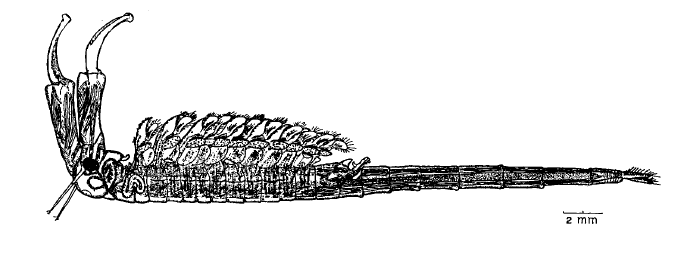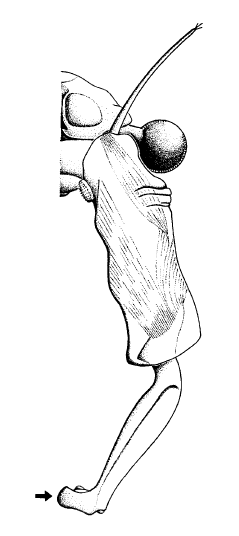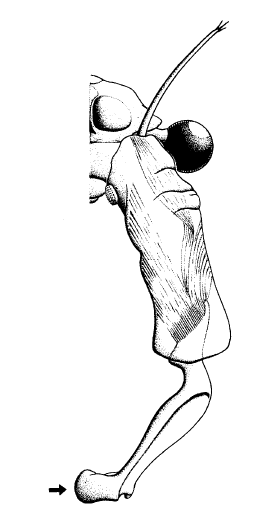I spent a day last week at the US Fish and Wildlife Service (USFWS) headquarters in Sacramento taking an exam to demonstrate my knowledge of fairy shrimp anatomy. In order to survey vernal pools and to document the distribution and abundance of the six species of endangered fairy shrimp that dwell in the Reserve, I need to be able to identify these look-alike species when I catch them in a net. Tadpole shrimp and clam shrimp are distinctive and can be identified with certainty in the hand. The dozen or so Branchinecta species, however, are another story. They can only be identified under a high powered microscope. Therein lies the challenge. These animals are small (1/4 to 3/4 inch); the specific characters that separate one species from another are subtle; and their correct identification requires judgment calls and developing a “gestalt” that helps me to recognize the differences among similar species. Because many fairy shrimp are on the federal endangered species list, anyone wishing to catch or survey these invertebrates must be authorized by the USFWS.
The sketch below by James E. Lynch (in Fairy Shrimps of California's Puddles, Pools and Playas, by C. Eriksen and D. Belk), depicts a male Branchinecta campestris. Shrimp swim "upside down" with their many pairs of legs or phylopods skulling the water and projecting from the top of the body.

California is home to about 23 different species of fairy shrimp. Over half have been discovered in our state just in the last 15 years or so. Their distribution and habitat requirements are not fully understood and new information is turned up regularly. A small, murky pool on the edge of an agricultural field could support two or three different species and new records from remote and far flung areas of the state are commonplace. To study these animals the first step is to know which species you have in hand. Therefore it’s important to have a working knowledge of the external anatomy of all the species that could turn up in a vernal pool. As the Reserve Director I'm required to know my fairy shrimp.
These fairy shrimp species occur in the Reserve:
Branchinecta lynchi (the Vernal Pool Fairy Shrimp)
Branchinecta mesovallensis (first described in 2000)
Branchinecta conservatio (a large, rare species)
Linderiella occidentalis (the California Fairy shrimp, a common and widespread species in the Central Valley)
Lepidurus packardi (a tadpole shrimp)
Cyzicus californicus (the California clam shrimp)
I sat down in the cool, air-conditioned Fish and Wildlife Service lab and unpacked my stereo dissecting scope. Without a good scope it’s not possible to see the tiny antennae that project from the head end of the shrimp. A good scope is a must. A magnifying glass would never work!
“By their antennae ye shall know them” – Anonymous.
My task was to examine and identify dozens of “unknown” shrimp and in so doing to convince USFWS biologist David Kelly that I was qualified to survey the vernal pools at UC Merced. Shrimp species are maddeningly similar, separated only by miniscule bumps, twists, and spines that adorn the antennae. David handed me 20 small vials, each one containing a different species of unidentified shrimp preserved in alcohol. He wished me good luck and left me alone in the lab. This was an open book test, so I spread before me the ID keys, sketches and other reference material that I had. I poured the contents of a vial into a petri dish, adjusted the microscope light to the best angle, and cranked the magnification up to 40 power. Now I had to use my recently-acquired knowledge and my skill with an ID key to assign a name to specimen. I’d been honing my ID skills in preparation for the exam by studying diagrams and illustrations on campus over the past week, but without any preserved specimens to study I could rely only on “book knowledge.”
Fairy shrimp anatomy is described with a special set of unique terminology, mostly centering on characteristics of the male’s thread-like antennae. Is there a pulvillus – a mound like area covered with minute spinules - at the base of the antennae? Is the distal segment curved or straight? Are there spines on the distal segment? Do antennae tips possess equal sized humps, do they curve back on themselves or are they shaped like the ends of a canoe? Is an apophysis present?
Male antennae are specially shaped and adapted to grasp the female during mating. As such, the males of each species have evolved their own unique pair of antennae which fit their mate perfectly; they will not fit a different species.
The sketches below by Ina Rae Lengyel (in Fairy Shrimps of California's Puddles, Pools and Playas, by C. Eriksen and D. Belk) show the right male antenna of Branchinecta mesovallenis (L) and Branchinecta conservatio (R).

Shifting back  and from 10X to 20X and up to 40 power, I gently rolled the moribund shrimp from side to side while searching for the clues I needed to pass the exam. My dichotomous key, prepared by Clyde Ericksen and Dento Belk (with recent appended notes by D. Christopher Rogers) guides me from one couplet to another. At each step I’m required to make a firm determination before moving on to next couplet. Using fine point forceps and a sharp probe I turn each shrimp to the best orientation so I can view the fine details of the antennae. Qualitative characters rather than quantitative ones (those that can be counted or measured) means I'm forced to make many judgment calls. Sound tricky (=frustrating)? It is! Patience and a manual dexterity definitely required. Add to the challenge the fact that the specimens are colorless and rather “shrunken” from the liquid preservative, and you get some sense of the challenge. After 6 or 8 decisions as I move through the key, I’m rewarded with a tentative determination. Working in reverse, I confirm my choice (no, it’s not a guess) until I feel confident that I’m correct. Success…at least momentary.
and from 10X to 20X and up to 40 power, I gently rolled the moribund shrimp from side to side while searching for the clues I needed to pass the exam. My dichotomous key, prepared by Clyde Ericksen and Dento Belk (with recent appended notes by D. Christopher Rogers) guides me from one couplet to another. At each step I’m required to make a firm determination before moving on to next couplet. Using fine point forceps and a sharp probe I turn each shrimp to the best orientation so I can view the fine details of the antennae. Qualitative characters rather than quantitative ones (those that can be counted or measured) means I'm forced to make many judgment calls. Sound tricky (=frustrating)? It is! Patience and a manual dexterity definitely required. Add to the challenge the fact that the specimens are colorless and rather “shrunken” from the liquid preservative, and you get some sense of the challenge. After 6 or 8 decisions as I move through the key, I’m rewarded with a tentative determination. Working in reverse, I confirm my choice (no, it’s not a guess) until I feel confident that I’m correct. Success…at least momentary.
The female of each species is even more difficult to distinguish than are the males. The main distinguishing features for females turns out to be the number of bumps along the dorso-lateral side of their body. Since seeing any bumps at all is nearly impossible with my scope and my particular eyes – I’m very near the limit of my visual abilities. By patiently adjusting the microscope lights and by moving between high and lower power, the crucial bumps come in to view. Relieved, I’m eventually able to observe and count the all-important female bumps. Are there bumps on anterior segment three? No. Do two conical projections comprise each bump? Yes. Such is the job of a vernal pool ecologist!
After several hours of staring intently at the preserved contents of 23 vials and marking my choices on the exam, I announced to my proctor that I’m finished. David pulls out the answer key, carefully compares my list of latin names and announces that I've passed.
Once I'm armed with an official “fairy shrimp survey certificate”, I’ll be able to study the shrimp in the campus pools and announce with confidence the identity of these small rare invertebrates that dwell in the endangered vernal pool habitats.


